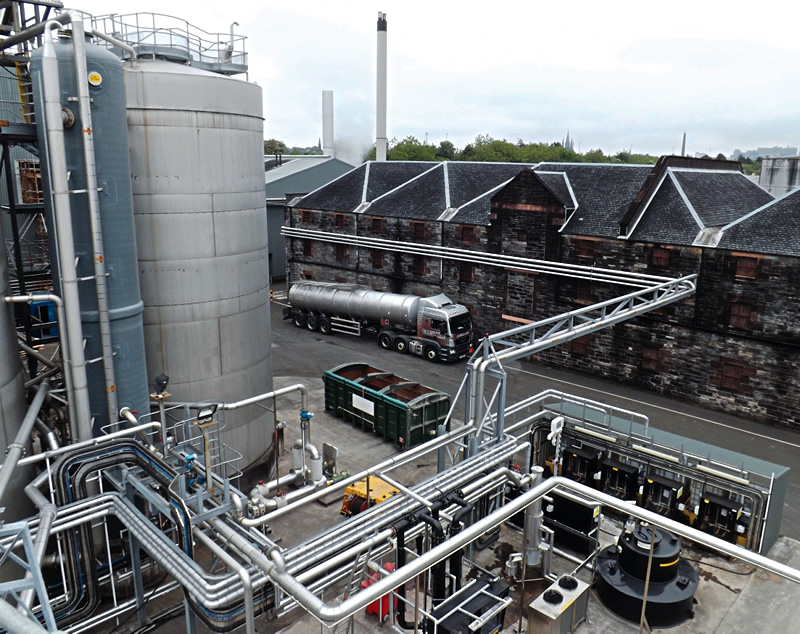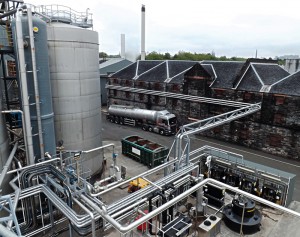BioCycle August 2013, Vol. 54, No. 8, p. 18
Washington, DC: AD Funding Fact Sheet
A very useful fact sheet, Funding On-Farm Anaerobic Digestion, is available on the US EPA AgSTAR website. It was brought to our attention recently when discussing the reality that one of the biggest obstacles to widespread adoption of on-farm anaerobic digestion has been its cost. In addition to significant amounts of up-front capital costs, the break-even prices for the electricity and fuel produced from the biogas are relatively high. The fact sheet discusses a variety of funding mechanisms to help overcome the cost burden, including grants, cash reimbursements, loan guarantees, industrial bonds, private funding, and other cost-sharing agreements. It also provides case studies of farm digesters that have utilized these forms of funding, as well as the digester’s operating costs. The following examples excerpted from the AgSTAR Fact Sheet, show the level of detail provided:
Butler Farms, a swine operation in North Carolina (NC), received multiple grants, a cost-share agreement, and a cash reimbursement to fund its covered lagoon anaerobic digestion (AD) system. Total capital cost for the digester was $550,000 to $650,000. The farm operator received a combined grant of $373,780 from the NC State Energy Office and the NC Green Business Fund, a $116,480 cost-share agreement from the USDA’s NRCS EQIP, a $20,000 grant from the NC Farm Bureau Federation’s Farm Energy Efficiency Program (FEEP) and a grant for 30 percent of eligible project cost from the U.S. Treasury’s Section 1603 Program. The balance (approximately $50,000) was paid out of pocket by the farm operator. The annual operating and maintenance costs for the digester and end-use equipment are approximately $25,000. The farm estimates that revenue from electricity sales will be approximately $56,000/year, without codigestion. (Butler Farms estimates that with the planned codigestion, electricity sales could be $130,600 per year.) The project vendor estimated that the simple payback period is 8 to 10 years; however, the farm operator hopes to shorten the payback period with increased biogas from a planned codigestion project.
Another example, Loyd Ray Farms in North Carolina (also a swine operation), had total capital costs of $1.2 million. About $500,000 in funding came from state and federal grants; the balance of $700,000 came from Duke University and Duke Energy as part of a three-party cost-sharing that also includes Google, Inc. Duke University and Google share the operational and maintenance expenses in return for a portion of the carbon offset credits. Duke Energy receives the Renewable Energy Credits over the life of the project. The farm operator did not incur any out-of-pocket expenses for system construction, nor is the operator responsible for operation and maintenance of the system. Access the fact sheet at www.epa.gov/agstar/documents/funding_digestion.pdf.
Edinburgh, Scotland: Scotch Distillery Digester
North British Distillery, the Edinburgh Scotch whisky grain distillery that produces brands such as Famous Grouse and Johnnie Walker Black Label, installed a high rate anaerobic digestion system to help provide a sustainable solution to a bottleneck in the back-end production process where spent distillers grain is used to make pellets for animal feed.
The AD plant was completed in two phases, and is capable of treating 59,500 lbs/day of Chemical Oxygen Demand (COD). It produces up to 24,000 MW hours of renewable energy in the form of biogas. Recently, North British Distillery, HydroThane UK and ENER-G won the AD & Biogas Association Award for Best Integration of AD into a Food and Drink Business. The $9.3 million green technology project has reduced the distillery’s carbon dioxide emissions by approximately 9,000 metric tons/year. A third phase of the project, completed in 2012, consisted of the construction of a water treatment plant that uses two large aerobic bioreactors and microfiltration membrane technology to process the effluent stream from the AD plant. This significantly improves the quality of the post-treated water before being discharged to local sewer, enabling up to 40 percent of the total volume to be recycled within the distillery. The distillery is working with the Bio-Fertiliser Association to have the biosolids produced from the aerobic process accredited under PAS110.
London, Ontario: Commercial Food Waste Digester
The first anaerobic digester in North America to be fueled solely by commercial food waste is being commissioned and is expected to go into full operation this fall, near London, Ontario. The “Energy Garden” facility, built and operated by Massachusetts-based Harvest Power Inc., has an annual capacity of about 70,000 tons. It will accept food scraps, fats, used fryer oils, grease and other wastes from restaurants, grocery stores and processing plants. Methane from the combined stirred tank reactor fuels a 6 MW generator that produces electricity to be sold to the Ontario grid under the provincial government’s Renewable Energy Standard Offer Program, or RESOP, which preceded the current Feed-in Tariff, or FIT. “It’s the largest of its kind processing only commercial food wastes,” says Harvest Power CEO Paul Sellew. Heat from the engine will be used internally, including for warming the digester. Digestate will be processed into liquid and dry granular natural fertilizers for farm applications and retail markets.
The facility, on a 10-acre site about a two-hour drive west of Toronto, was originally developed by a company called StormFisher Biogas. Greenhouse Gas Services, a Virginia company, acquired it in 2009, then backed out because it lacked financing. Harvest Power acquired the project the following year and took over the 20-year RESOP power purchase contract with the Ontario Power Authority. Under that program, later replaced by the more generous FIT, the province pays a premium rate for electricity from wind, solar, water, biomass and other renewable sources.
Harvest Power added substantial upgrades, including improved odor controls and two pits where the food wastes will be mixed with water before being fed into the digester. The company recently opened a digester facility in Richmond, a suburb of Vancouver, British Columbia, to process residential organics. It also runs a composting plant at the site.
Paris, France: New Biogas Handbook
The IEA Bioenergy, created by the International Energy Agency (IEA) based in Paris, collaborated with anaerobic digestion (AD) experts in their respective fields, to produce The Biogas Handbook: Science, Production and Applications, edited by Arthur Wellinger, Jerry Murphy and David Baxter, and published by Woodhead Publishing. The 508-page hardcover book is targeted at a range of readers, note the editors, providing detailed information on the whole biogas process chain “and thereby to be a sound basis for readers with a least a basic understanding of science or engineering who want to become knowledgeable in the field of biogas. The level is aimed at degree and masters level students, project planners, policy makers and regulators.” The Biogas Handbook covers all aspects in the chain from the origin of the biomass feedstocks, feedstock selection and preparation, the AD process, biogas plant equipment design and operation, through to utilization of the biogas for energy production and the residue, the digestate, as a biofertilizer. The 19-chapter handbook is divided into three sections, beginning with the fundamentals in Part I, plant design, operation, process optimization and digestate utilization in Part II, and biogas utilization in Part III.
BioCycle Editor Nora Goldstein wrote the Foreword to The Biogas Handbook, which provided an opportunity to read a final draft prior to publication. Goldstein writes that she was “struck by” the following statement in Chapter 6, ‘Optimisation of biogas yields from anaerobic digestion by feedstock type,’ authored by Charles Banks and Sonia Heaven with Southampton University in the U.K.: “We have to overcome the idea that an anaerobic digester is a rudimentary low-technology waste treatment and disposal system, and replace it with one of a process capable of delivering the multiple benefits of low-cost second-generation renewable energy production, a sustainable route to nutrient recycling and a means of abating GHG emissions,” wrote Banks and Heaven. The extent and depth of knowledge and experience captured in The Biogas Handbook will help the emerging AD and biogas industries “construct and operate state-of-the art (and science) biogas plants,” concluded Goldstein. “As an Editor, I am impressed with the handbook’s ability to convey technical and scientific information in a style that can be understood by individuals with varying levels of knowledge about the topics discussed.” Ordering information is available at www.woodheadpublishing.com.
San Diego, California: Reducing Biogas Engine Emissions
The California Air Resources Board’s NOx (nitrogen oxide) emissions standard for stationary biogas internal combustion engines is 0.07 lbs of NOx/MWh (roughly 2-3 ppm of NOx at 15% 02 levels). Meeting this standard has been challenging for anaerobic digesters (AD) using biogas engines. Biogas & Electric, based in San Diego, received several grants from USDA’s Small Business Innovation Research program, along with seed funding from Waste Management, Inc., to develop a NOx reduction system for biogas engines at agricultural and municipal wastewater AD facilities. In July, the company released a white paper based on the R&D that describes its wet scrubbing technology, NOxRx®, that reduces NOx and SOx (sulfur oxide) emissions from the exhaust stream of a biogas-fired engine. Results from a full-scale demonstration at a 3,500 head flushed lane California dairy are included. The dairy uses a stirred, covered lagoon digester (about 30 million gallon capacity), and has a 300 kW Guascor CHP engine. Biogas passes through a coiled-loop chiller to condense and remove water prior to combustion; there is no hydrogen sulfide removal. The exhaust gas composition was 50 to 100 ppm NOx and 400 to 1,000 ppm SOx.
The NoxRx system installed employs a multistage wet scrubbing system that uses effluent from the anaerobic digester. The process is noncatalytic, therefore siloxane and H2S removal are not needed prior to combustion for effective emission reduction purposes, according to the company. The white paper states that emissions reductions during the technology demonstration were as follows: NOx—37 ppm before and 2 ppm after (adjusted to 15% 02 basis); SOx—585 ppm before and <0.1 ppm after treatment.











